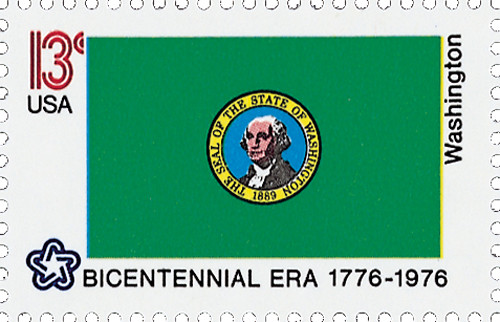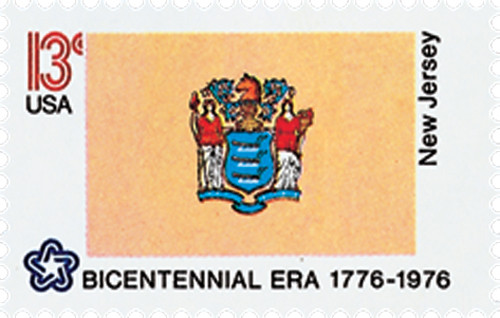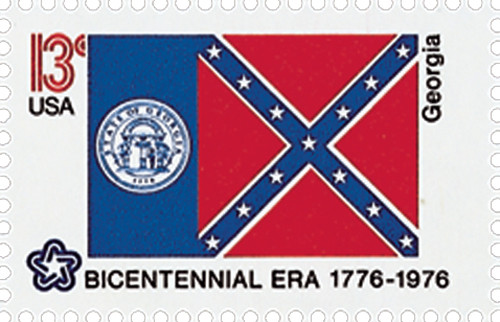
# 1674 - 1976 13c State Flags: Washington
U.S. 1674
1976 Washington
State Flags
American Bicentennial Series
• First time a sheet 50 had all different stamp designs
• Part of the American Bicentennial Series
Stamp Category: Commemorative
Series: American Bicentennial Series
Value: 13¢ First-class postage rate
First Day of Issue: February 23, 1976
First Day City(s): Washington, DC
Quantity Issued: 8,720,100 (panes of 50)
Printed by: Bureau of Engraving and Printing
Printing Method: Photogravure
Format: Sheet of 50
Perforations: 11
Why the stamp was issued:
The United States Postal Service celebrated the American Bicentennial with a full pane of the Union’s fifty state flags.
About the stamp design:
Like many states, Washington features its state seal for the center of the flag. It is the only state flag picturing an actual person.
When the design for the seal was first discussed, a complicated landscape was proposed to reflect the state’s natural beauty. Charles Talcott, an engraver, offered an alternative arrangement. He placed a postage stamp bearing George Washington’s image within a double ring with The Seal of the State of Washington 1889†written between the rings. The simple pattern was adopted.
Two groups are credited with designing the state flag. The chairperson for the Daughters of the American Revolution was asked to submit a flag to hang at the National headquarters. She presented a green flag with the state seal in the center. When the Washington State Nautical School needed a flag for their training ship, they also used the seal on a green field.
Washington is the Evergreen State, so the flag’s color is fitting. It is the only green state flag.
The state of Washington approved their official state flag in 1923, 34 years after statehood. Using an image of George Washington was a logical choice for the only state named after a President.
About the printing process:
Printed by the Bureau of Engraving and Printing on their seven-color Andreotti gravure press (601) which was their work horse for multicolored stamps.
About the American Bicentennial Series:
In the 1970s, America celebrated its 200th anniversary with hundreds of national events commemorating the heroes and historic events that led to our nation’s independence from Great Britain. The U.S. Postal Service issued 113 commemorative stamps over a six-year period in honor of the U.S. bicentennial, beginning with the American Revolution Bicentennial Commission Emblem stamp (U.S. #1432). As a group, the Bicentennial Series chronicles one of our nation’s most important chapters, and remembers the events and patriots who made the U.S. a world model for liberty.
Several of the stamps honored colonial life – craftsmen and communication. Other stamps honored important battles including Lexington and Concord, Bunker Hill, and Saratoga. Significant events such as the Boston Tea Party, the meeting of the First Continental Congress, and the Declaration of Independence were featured as well. The stamps also honored many significant people such as George Washington, Sybil Ludington, Salem Poor, and the Marquis de Lafayette.
Many of the stamps feature classic artwork. For instance, the set of four souvenir sheets picture important events recreated by noted artists such as John Trumbull. The Bicentennial Series also includes an important US postal first – the first 50-stamp se-tenant – featuring all 50 state flags. The format proved to be popular with collectors, and has been repeated many times since.
The American Bicentennial Series is packed with important US history – it tells the story of our nation’s fight for independence through stamps.
History the stamp represents:
On November 11, 1889, Washington was admitted to the Union.
Before the arrival of Europeans, a large number of American Indians lived in what would become the state of Washington. The Cayuse, Colville, Nez Perce, Okanogan, Spokane, and Yakima tribes lived on the plains and in river valleys. The Chinook, Clallam, Clatsop, Nisqually, Nooksack, and Puyallup lived along the coast, west of the Cascade Mountains.
Spanish and English explorers sailing north from California in the 1500s were probably the first whites to sight Washington. However, Europeans did not set foot in Washington until the late 1700s. When Russian fur traders settled in Alaska, the Spanish became worried they might also claim Washington. As a result, the Spanish sent several expeditions to the area to reinforce their claim. In 1775, Bruno Heceta and Juan Francisco de la Bogeda y Quadra were the first whites to land on Washington soil.
1n 1778, Captain James Cook became the first English explorer to reach this area. However, he did not get to view much of the coast, due to stormy weather. The English Captain George Vancouver completed surveys of Puget Sound and Georgia Gulf in 1794. His officer, Peter Puget, reached Puget Sound in 1792. These explorations were the basis for England’s claim to the region.
The first American to reach Washington was Captain Robert Gray of the Boston Company. Gray headed a fur-trading expedition that sailed into the harbor that now bears his name. He reached the mouth of the Columbia River in 1792. Gray’s explorations became the source of American claims to the area. In 1805, the Lewis and Clark Expedition explored Washington by following the route of the Columbia River to the Pacific Ocean. The Lewis and Clark Expedition gave America another claim to the land of the northwest.
By the early 1800s, fur traders from U.S. and Britain had settled in the region. In 1810, the Canadian North West Company established Spokane House near today’s Spokane. Fur trader John Jacob Astor established the first permanent American settlement with the founding of Fort Okanogan.
The fur trade was interrupted by the War of 1812. After the war, Britain and the U.S. could not agree on how to separate the land west of the Rocky Mountains. In a compromise, it was decided citizens of both nations could settle this vast area, then known as Oregon Country. However, by the 1840s, a large number of Americans had settled the Oregon Country, and boundary dispute became a bitter issue.
During the presidential election of 1844, James K. Polk based a great deal of his campaign on the idea that any land south of latitude 54 40 belonged to the U.S. His supporters used the slogan, Fifty-four forty or fight! President Polk signed a treaty with Great Britain that set the boundary at the 49th parallel, Washington’s current border, in 1846.
The Oregon Territory was created in 1848. Washington was part of this vast piece of land until 1853, when President Millard Fillmore created the Washington Territory. The Washington Territory included all of today’s Washington and parts of Idaho and Montana. The territory was expanded to include the southern parts of Idaho and Wyoming in 1859.
When the Idaho Territory was established in 1863, Washington received its current boundaries. Washington’s population grew fast, fueled by the discovery of gold in Idaho, Oregon, and British Columbia. Yet, there were no major gold strikes in Washington. Many gold prospectors remained there and became farmers or loggers.
In 1883, Washington was connected to the East by rail. This caused its population to grow rapidly, leading to calls for statehood. On November 11, 1889, President Benjamin Harrison declared Washington a state. Olympia became the state capital.
U.S. 1674
1976 Washington
State Flags
American Bicentennial Series
• First time a sheet 50 had all different stamp designs
• Part of the American Bicentennial Series
Stamp Category: Commemorative
Series: American Bicentennial Series
Value: 13¢ First-class postage rate
First Day of Issue: February 23, 1976
First Day City(s): Washington, DC
Quantity Issued: 8,720,100 (panes of 50)
Printed by: Bureau of Engraving and Printing
Printing Method: Photogravure
Format: Sheet of 50
Perforations: 11
Why the stamp was issued:
The United States Postal Service celebrated the American Bicentennial with a full pane of the Union’s fifty state flags.
About the stamp design:
Like many states, Washington features its state seal for the center of the flag. It is the only state flag picturing an actual person.
When the design for the seal was first discussed, a complicated landscape was proposed to reflect the state’s natural beauty. Charles Talcott, an engraver, offered an alternative arrangement. He placed a postage stamp bearing George Washington’s image within a double ring with The Seal of the State of Washington 1889†written between the rings. The simple pattern was adopted.
Two groups are credited with designing the state flag. The chairperson for the Daughters of the American Revolution was asked to submit a flag to hang at the National headquarters. She presented a green flag with the state seal in the center. When the Washington State Nautical School needed a flag for their training ship, they also used the seal on a green field.
Washington is the Evergreen State, so the flag’s color is fitting. It is the only green state flag.
The state of Washington approved their official state flag in 1923, 34 years after statehood. Using an image of George Washington was a logical choice for the only state named after a President.
About the printing process:
Printed by the Bureau of Engraving and Printing on their seven-color Andreotti gravure press (601) which was their work horse for multicolored stamps.
About the American Bicentennial Series:
In the 1970s, America celebrated its 200th anniversary with hundreds of national events commemorating the heroes and historic events that led to our nation’s independence from Great Britain. The U.S. Postal Service issued 113 commemorative stamps over a six-year period in honor of the U.S. bicentennial, beginning with the American Revolution Bicentennial Commission Emblem stamp (U.S. #1432). As a group, the Bicentennial Series chronicles one of our nation’s most important chapters, and remembers the events and patriots who made the U.S. a world model for liberty.
Several of the stamps honored colonial life – craftsmen and communication. Other stamps honored important battles including Lexington and Concord, Bunker Hill, and Saratoga. Significant events such as the Boston Tea Party, the meeting of the First Continental Congress, and the Declaration of Independence were featured as well. The stamps also honored many significant people such as George Washington, Sybil Ludington, Salem Poor, and the Marquis de Lafayette.
Many of the stamps feature classic artwork. For instance, the set of four souvenir sheets picture important events recreated by noted artists such as John Trumbull. The Bicentennial Series also includes an important US postal first – the first 50-stamp se-tenant – featuring all 50 state flags. The format proved to be popular with collectors, and has been repeated many times since.
The American Bicentennial Series is packed with important US history – it tells the story of our nation’s fight for independence through stamps.
History the stamp represents:
On November 11, 1889, Washington was admitted to the Union.
Before the arrival of Europeans, a large number of American Indians lived in what would become the state of Washington. The Cayuse, Colville, Nez Perce, Okanogan, Spokane, and Yakima tribes lived on the plains and in river valleys. The Chinook, Clallam, Clatsop, Nisqually, Nooksack, and Puyallup lived along the coast, west of the Cascade Mountains.
Spanish and English explorers sailing north from California in the 1500s were probably the first whites to sight Washington. However, Europeans did not set foot in Washington until the late 1700s. When Russian fur traders settled in Alaska, the Spanish became worried they might also claim Washington. As a result, the Spanish sent several expeditions to the area to reinforce their claim. In 1775, Bruno Heceta and Juan Francisco de la Bogeda y Quadra were the first whites to land on Washington soil.
1n 1778, Captain James Cook became the first English explorer to reach this area. However, he did not get to view much of the coast, due to stormy weather. The English Captain George Vancouver completed surveys of Puget Sound and Georgia Gulf in 1794. His officer, Peter Puget, reached Puget Sound in 1792. These explorations were the basis for England’s claim to the region.
The first American to reach Washington was Captain Robert Gray of the Boston Company. Gray headed a fur-trading expedition that sailed into the harbor that now bears his name. He reached the mouth of the Columbia River in 1792. Gray’s explorations became the source of American claims to the area. In 1805, the Lewis and Clark Expedition explored Washington by following the route of the Columbia River to the Pacific Ocean. The Lewis and Clark Expedition gave America another claim to the land of the northwest.
By the early 1800s, fur traders from U.S. and Britain had settled in the region. In 1810, the Canadian North West Company established Spokane House near today’s Spokane. Fur trader John Jacob Astor established the first permanent American settlement with the founding of Fort Okanogan.
The fur trade was interrupted by the War of 1812. After the war, Britain and the U.S. could not agree on how to separate the land west of the Rocky Mountains. In a compromise, it was decided citizens of both nations could settle this vast area, then known as Oregon Country. However, by the 1840s, a large number of Americans had settled the Oregon Country, and boundary dispute became a bitter issue.
During the presidential election of 1844, James K. Polk based a great deal of his campaign on the idea that any land south of latitude 54 40 belonged to the U.S. His supporters used the slogan, Fifty-four forty or fight! President Polk signed a treaty with Great Britain that set the boundary at the 49th parallel, Washington’s current border, in 1846.
The Oregon Territory was created in 1848. Washington was part of this vast piece of land until 1853, when President Millard Fillmore created the Washington Territory. The Washington Territory included all of today’s Washington and parts of Idaho and Montana. The territory was expanded to include the southern parts of Idaho and Wyoming in 1859.
When the Idaho Territory was established in 1863, Washington received its current boundaries. Washington’s population grew fast, fueled by the discovery of gold in Idaho, Oregon, and British Columbia. Yet, there were no major gold strikes in Washington. Many gold prospectors remained there and became farmers or loggers.
In 1883, Washington was connected to the East by rail. This caused its population to grow rapidly, leading to calls for statehood. On November 11, 1889, President Benjamin Harrison declared Washington a state. Olympia became the state capital.

















